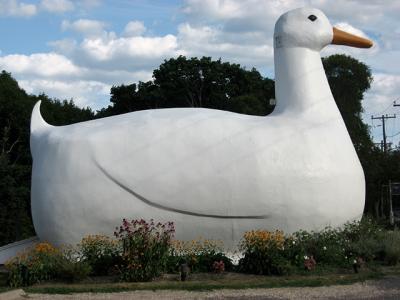More Than a Roadside Attraction

It was once a reliable feature of a Montauk Highway drive through Water Mill: the hammerblow of animal stink as you passed John Bellini’s duck farm. Windows were frantically cranked skyward, hands flew to cover mouths, children groaned from the back seat. And then it was gone as you continued on into Bridgehampton, just as nearly the entire Long Island duck farm industry disappeared in our collective rearview mirror starting in the 1970s.
Water pollution complaints, government regs, and ever-present development pressures doomed the Bellini farm, and for that matter the rest of them, about 100 in all at the industry’s zenith, the 1940s, when they were producing six to eight million ducklings a year, Susan Van Scoy tells us in her new book, “The Big Duck and Eastern Long Island’s Duck Farming Industry,” the “eastern” in this case stretching west to Eastport and Center Moriches, where the biggest farms were.
By 1974, the 27 that remained were still responsible for 70 percent of the country’s duckling supply. Today there’s just one left on the East End, the Corwin family’s Crescent Duck Farm in Aquebogue.
The book, part of Arcadia Publishing’s Images of America series, came out this week, and adding to the newness is a book launch on Tuesday at 7:30 p.m. at the David W. Crohan Community Center on Route 24 in Flanders, sponsored by the Flanders Village Historical Society (the group runs an amply illustrated website well worth a click) and the Friends of the Big Duck, which will benefit from the author talk and signing with refreshments.
Ms. Van Scoy is a professor of art history at St. Joseph’s College in Patchogue, “specializing,” according to the back-jacket copy, “in the history of photography and site-specific art,” making her particularly well suited to the project at hand, as the book proceeds chronologically, one photo and caption at a time, from a 1920 shot of two scraggly “three-week-old Pekin ducklings” padding around the W.W. Lukert farm in Center Moriches up to a photo from last year showing the restored Victorian barn that houses the Long Island Duck Farm Exhibit at the site of the famous Big Duck in Flanders.
That imperious 20-foot-tall creature of reinforced concrete, built in 1931, inhabits the last third or so of Ms. Van Scoy’s book, and among the eye-openers is the fact that it first roosted in an area called Upper Mills in Riverhead before being moved to Flanders five years later after the marketing boost it provided made Martin Maurer’s retail business a success.
In some ways it’s surprising the duck survived all those decades when so much else was swept away. The so-named Big Duck Ranch was put on the National Register of Historic Places in 2008, the same year another establishment related to the vanished industry, John Duck Jr.’s restaurant in Southampton, was shuttered after “failing to bow to the trendy tastes of summer crowds.”
Well put, Ms. Van Scoy.
